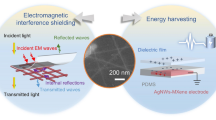Abstract
We report on non-particulate titania photoelectrodes with a unique highly-ordered nanotube-array architecture prepared by an anodization process that enables precise control over array dimensions. Under 320–400 nm illumination titania nanotube-array photoanodes, pore size 110 nm, wall thickness 20 nm, and 6 μm length, generate hydrogen by water photoelectrolysis at a normalized rate of 80 mL/W·hr, to date the most efficient titania-based photoelectrochemical device, with a conversion efficiency of 12.25%. The highly-ordered nanotubular architecture allows for superior charge separation and charge transport, with a calculated quantum efficiency of nearly 100% for incident photons with energies larger than the titania bandgap.
Similar content being viewed by others
References
V. M. Aroutiounian, V. M. Arakelyan, G. E. Shahnazaryan, Solar Energy and references therein, in press (2004)
M. Gratzel, Journal of Photochemistry and Photobiology C-Photochemistry Reviews 4, 145–153 (2003)
M. Gratzel, Nature 414, 338–344 (2001)
M. Gratzel, Journal of Photochemistry and Photobiology a-Chemistry 164, 3–14 (2004)
M. K. Nazeeruddin et al., Journal of the American Chemical Society 123, 1613–1624 (2001)
F. Cao, G. Oskam, G. J. Meyer, P. C. Searson, Journal of Physical Chemistry 100, 17021–17027 (1996)
P. E. deJongh, D. Vanmaekelbergh, Physical Review Letters 77, 3427–3430 (1996)
X. Zhang et al., Journal of the Electrochemical Society 148, G398–G400 (2001)
S. J. Limmer, T. P. Chou, G. Z. Cao, Journal of Materials Science 39, 895–901 (2004)
S. Yoo, S. A. Akbar, K. H. Sandhage, Adv. Mater. 16, 260 (2004)
M. Adachi, Y. Murata, I. Okada, S. Yoshikawa, Journal of the Electrochemical Society, 150, G488–G493 (2000)
Y. C. Zhu, H. L. Li, Y. Koltypin, Y. R. Hacohen, A. Gedanken, Chemical Communications, 24, 2616–2617 (2001)
T. Y. Peng, A. Hasegawa, J. R. Qiu, K. Hirao, Chemistry of Materials 15, 2011–2016 (2003)
I. M. Butterfield et al., Journal of Applied Electrochemistry 27, 385–395 (1997)
O. K. Varghese, D. W. Gong, M. Paulose, C. A. Grimes, E. C. Dickey, Journal of Materials Research 18, 156–165 (2003)
G. K. Mor, O. K. Varghese, M. Paulose, N. Mukherjee, C. A. Grimes, Journal of Materials Research 18, 2588–2593 (2003)
O.K. Varghese, G. K. Mor, C. A. Grimes, M. Paulose, N. Mukherjee, J. Nanoscience Nanotechnology 4, 733 (2004)
We note the hydrogen sensitivity of the material is the largest known sensitivity of any material, to any gas, at any temperature; at 23°C in response to 1000 ppm hydrogen the nanotubes demonstrate a 1,000,000,000% change in electrical resistivity.
G. K. Mor, M. A. Carvalho, O. K. Varghese, M. V. Pishko, C. A. Grimes, Journal of Materials Research 19, 628–634 (2004)
D. Vanmaekelbergh, P. E. de Jongh, Journal of Physical Chemistry B 103, 747–750 (1999)
A. Hamnett, Faraday Discussions of the Chemical Society 70, 127 (1980)
K.-N. P. Kumar, K. Keizer, A. J. Burggraaf, T. Okubo and H. Nagamoto, J. Mater. Chem. 3, 1151 (1993)
P.I. Gouma and M.J. Mills, J. Am. Ceram. Soc. 84, 619 (2001)
A. Hagfeldt and M. Gratzel, Chemical Reviews 95, 49 (1995)
Author information
Authors and Affiliations
Corresponding author
Rights and permissions
About this article
Cite this article
Paulose, M., Varghese, O.K., Shankar, K. et al. Photoelectrochemical Properties of Highly-ordered Titania Nanotube-arrays. MRS Online Proceedings Library 837, 39–44 (2004). https://doi.org/10.1557/PROC-837-N3.13
Published:
Issue Date:
DOI: https://doi.org/10.1557/PROC-837-N3.13




